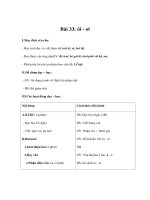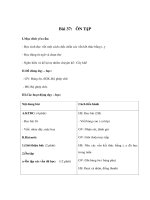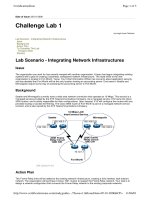Tài liệu ISDN Lab Scenario 1 -- OSPF Build to Specifications docx
Bạn đang xem bản rút gọn của tài liệu. Xem và tải ngay bản đầy đủ của tài liệu tại đây (68.74 KB, 16 trang )
CertificationZone Page 1 of 16
11/06/01
Date of Issue: 11-01-2000
ISDN Lab Scenario 1 -- OSPF Build to
Specifications
Introduction
This lab is designed to be a build-to-specifications test. There are numerous issues that need to be addressed for this
lab to work correctly. The lab is designed to illustrate some of the problems associated with ISDN and link state
routing protocols, such as OSPF. This lab will concentrate on dialer profiles while the second lab scenario will be a
troubleshooting scenario based on a distance vector protocol and legacy DDR configuration. The two scenarios are
designed to thoroughly test your knowledge of the basics of ISDN configuration. All CCIE candidates are well advised
to master all aspects of ISDN. Make use of the question mark for each ISDN command and each PPP command and
write your own scenarios so that you have seen every possible option for every command before you attempt the
CCIE lab exam. These labs are also designed to force you to concentrate on ISDN configurations by limiting the
amount of external equipment, while maximizing IOS features such as virtual token-ring interfaces and loopbacks for
added complexity.
Network Specifications
When you are finished troubleshooting the network, it should meet the following specifications:
1. 1. Configure dialer profiles on each router.
2. 2. Use a form of authentication that does not send the password over the network in the clear where a sniffer
might be able to intercept it. Use the hostname CCIE1 for router 1 and CCIE2 for router 2 for authentication;
but the router hostnames must be r1 and r2 respectively.
3. 3. Do not allow OSPF hellos to keep the ISDN line up indefinitely. The ISDN line should only come up when
the Ethernet connection fails.
4. 4. Configure OSPF for the network. The ISDN link, the Ethernet, and the loopback 0 interfaces on each router
should be placed into OSPF area 0. On router 1, loopback 1 should be placed in OSPF area 1, and loopback
2 should be placed into OSPF area 2. On router 2, loopback 1 should be placed into OSPF area 11, and
loopback 2 should be placed into area 12.
5. 5. Configure r2 such that the physical BRI interface does not enter the standby mode in case we want to
configure AppleTalk on these routers. Configure r2 so that it will monitor the state of the Ethernet port and
bring up the ISDN line if the Ethernet port fails. R2 should wait for 2 seconds before bringing up the ISDN line
when the Ethernet port fails and should disconnect 2 seconds after the Ethernet port comes back up.
The Starting Configurations
The actual equipment that I used to develop this lab included a simple switch, a Cisco 1604 router, and a Cisco 2610
router. The ISDN simulator was a Teltone ISDN Demonstrator with 2 U interfaces. You will need to adjust the lab
contents to fit your ISDN simulator and/or routers as necessary. Here is the basic starting point for cabling your
equipment:
ISDN Information for Router1
isdn switch-type basic-ni
isdn spid1 0835866101 8358661
isdn spid2 0835866301 8358663
ISDN Information for Router2
isdn spid1 0835866201 8358662
CertificationZone Page 2 of 16
11/06/01
isdn spid2 0835866401 8358664
Hints
l • Do we need any dialer map statements? No, we do not. All we need is a dial string for dialer profiles since
we have a dialer remote name.
l • Can you ping every interface on both routers? You should be able to.
l • To help keep the line quiet, investigate the OSPF demand circuit command.
l • To bring up the line when the Ethernet port fails, use the backup set of commands.
l • To configure authentication, use the alternate method of ppp chap authentication.
Solution
Here are the final routing tables for the lab.
r1#sh ip route
Codes: C - connected, S - static, I - IGRP, R - RIP, M - mobile, B - BGP
D - EIGRP, EX - EIGRP external, O - OSPF, IA - OSPF inter area
N1 - OSPF NSSA external type 1, N2 - OSPF NSSA external type 2
E1 - OSPF external type 1, E2 - OSPF external type 2, E - EGP
i - IS-IS, L1 - IS-IS level-1, L2 - IS-IS level-2, ia - IS-IS inter area
* - candidate default, U - per-user static route, o - ODR
P - periodic downloaded static route
Gateway of last resort is not set
192.168.10.0/32 is subnetted, 1 subnets
O 192.168.10.1 [110/11] via 192.168.1.201, 00:00:24, Ethernet0/0
172.19.0.0/30 is subnetted, 1 subnets
C 172.19.1.4 is directly connected, Dialer0
10.0.0.0/32 is subnetted, 6 subnets
O 10.10.11.2 [110/11] via 192.168.1.212, 00:00:24, Ethernet0/0
C 10.10.11.1 is directly connected, Loopback0
C 10.10.13.1 is directly connected, Loopback2
C 10.10.12.1 is directly connected, Loopback1
O IA 10.10.12.2 [110/11] via 192.168.1.212, 00:00:24, Ethernet0/0
O IA 10.10.13.2 [110/11] via 192.168.1.212, 00:00:25, Ethernet0/0
C 192.168.1.0/24 is directly connected, Ethernet0/0
r1#
Notice that the source of the routes here is the Ethernet 0 interface.
r2#sh ip route
Codes: C - connected, S - static, I - IGRP, R - RIP, M - mobile, B - BGP
D - EIGRP, EX - EIGRP external, O - OSPF, IA - OSPF inter area
N1 - OSPF NSSA external type 1, N2 - OSPF NSSA external type 2
E1 - OSPF external type 1, E2 - OSPF external type 2, E - EGP
i - IS-IS, L1 - IS-IS level-1, L2 - IS-IS level-2, * - candidate default
U - per-user static route, o - ODR
CertificationZone Page 3 of 16
11/06/01
Gateway of last resort is not set
192.168.10.0/32 is subnetted, 1 subnets
O 192.168.10.1 [110/11] via 192.168.1.201, 00:00:41, Ethernet0
10.0.0.0/32 is subnetted, 6 subnets
C 10.10.11.2 is directly connected, Loopback0
O 10.10.11.1 [110/11] via 192.168.1.211, 00:00:41, Ethernet0
O IA 10.10.13.1 [110/11] via 192.168.1.211, 00:00:41, Ethernet0
O IA 10.10.12.1 [110/11] via 192.168.1.211, 00:00:41, Ethernet0
C 10.10.12.2 is directly connected, Loopback1
C 10.10.13.2 is directly connected, Loopback2
C 192.168.1.0/24 is directly connected, Ethernet0
Notice that the dialer interface is in standby mode, not the physical BRI interface.
r2#sh int dialer 0
Dialer0 is standby mode, line protocol is down
Hardware is Unknown
Internet address is 172.19.1.5/30
MTU 1500 bytes, BW 56 Kbit, DLY 20000 usec,
reliability 255/255, txload 1/255, rxload 1/255
Encapsulation PPP, loopback not set
DTR is pulsed for 1 seconds on reset
Last input never, output never, output hang never
Last clearing of "show interface" counters never
Input queue: 0/75/0 (size/max/drops); Total output drops: 0
Queueing strategy: weighted fair
Output queue: 0/1000/64/0 (size/max total/threshold/drops)
Conversations 0/0/256 (active/max active/max total)
Reserved Conversations 0/0 (allocated/max allocated)
5 minute input rate 0 bits/sec, 0 packets/sec
5 minute output rate 0 bits/sec, 0 packets/sec
0 packets input, 0 bytes, 0 no buffer
Received 0 broadcasts, 0 runts, 0 giants, 0 throttles
0 input errors, 0 CRC, 0 frame, 0 overrun, 0 ignored, 0 abort
0 packets output, 0 bytes, 0 underruns
0 output errors, 0 collisions, 0 interface resets
0 output buffer failures, 0 output buffers swapped out
0 carrier transitions
Notice that the backup interface is specified as Dialer0. Notice also that the failure delay is set to 2 seconds, and the
disable delay is also set to 2 seconds.
r2#sh int e 0
Ethernet0 is up, line protocol is up
Hardware is QUICC Ethernet, address is 0010.7b00.5011 (bia 0010.7b00.5011)
Internet address is 192.168.1.212/24
Backup interface Dialer0, kickin load not set, kickout load not set
failure delay 2 sec, secondary disable delay 2 sec
MTU 1500 bytes, BW 10000 Kbit, DLY 1000 usec,
reliability 255/255, txload 1/255, rxload 1/255
Encapsulation ARPA, loopback not set, keepalive set (10 sec)
ARP type: ARPA, ARP Timeout 04:00:00
Last input 00:00:05, output 00:00:03, output hang never
Last clearing of "show interface" counters never
Queueing strategy: fifo
Output queue 0/40, 0 drops; input queue 0/75, 0 drops
5 minute input rate 0 bits/sec, 0 packets/sec
5 minute output rate 0 bits/sec, 0 packets/sec
225 packets input, 33227 bytes, 0 no buffer
Received 206 broadcasts, 0 runts, 0 giants, 0 throttles
0 input errors, 0 CRC, 0 frame, 0 overrun, 0 ignored, 0 abort
0 input packets with dribble condition detected
128 packets output, 18052 bytes, 0 underruns
0 output errors, 0 collisions, 3 interface resets
0 babbles, 0 late collision, 0 deferred
0 lost carrier, 0 no carrier
0 output buffer failures, 0 output buffers swapped out
Now we can see that the Ethernet fails and the ISDN line comes up. Now check the routing table and see that most
routes are sourced from the dialer 0 interface.
r2#sh debug
CertificationZone Page 4 of 16
11/06/01
General Ethernet:
Ethernet network interface debugging is on
Dial on demand:
Dial on demand events debugging is on
r2#
00:18:19: %QUICC_ETHER-1-LOSTCARR: Unit 0, lost carrier. Transceiver problem?
00:18:20: %LINEPROTO-5-UPDOWN: Line protocol on Interface
Ethernet0, changed state to down
00:18:22: BRI0: rotor dialout [priority]
00:18:22: BRI0: Dialing cause ip (s=172.19.1.5, d=224.0.0.5)
00:18:22: BRI0: Attempting to dial 8358661
00:18:22: %LINK-3-UPDOWN: Interface BRI0:1, changed state to up
00:18:22: %DIALER-6-BIND: Interface BRI0:1 bound to profile Dialer0
00:18:22: dialer Protocol up for BR0:1
00:18:23: %LINEPROTO-5-UPDOWN: Line protocol on Interface BRI0:1,
changed state to up
00:18:24: %LINK-3-UPDOWN: Interface Dialer0, changed state to up
00:18:28: %ISDN-6-CONNECT: Interface BRI0:1 is now connected to 8358661 CCIE1
r2#sh ip route
Codes: C - connected, S - static, I - IGRP, R - RIP, M - mobile, B - BGP
D - EIGRP, EX - EIGRP external, O - OSPF, IA - OSPF inter area
N1 - OSPF NSSA external type 1, N2 - OSPF NSSA external type 2
E1 - OSPF external type 1, E2 - OSPF external type 2, E - EGP
i - IS-IS, L1 - IS-IS level-1, L2 - IS-IS level-2, * - candidate default
U - per-user static route, o - ODR
Gateway of last resort is not set
192.168.10.0/32 is subnetted, 1 subnets
O 192.168.10.1 [110/1796] via 172.19.1.6, 00:00:06, Dialer0
172.19.0.0/16 is variably subnetted, 2 subnets, 2 masks
C 172.19.1.6/32 is directly connected, Dialer0
C 172.19.1.4/30 is directly connected, Dialer0
10.0.0.0/32 is subnetted, 6 subnets
C 10.10.11.2 is directly connected, Loopback0
O 10.10.11.1 [110/1786] via 172.19.1.6, 00:00:06, Dialer0
O IA 10.10.13.1 [110/1786] via 172.19.1.6, 00:00:06, Dialer0
O IA 10.10.12.1 [110/1786] via 172.19.1.6, 00:00:06, Dialer0
C 10.10.12.2 is directly connected, Loopback1
C 10.10.13.2 is directly connected, Loopback2
O 192.168.1.0/24 [110/1795] via 172.19.1.6, 00:00:07, Dialer0
r2#un all
R1's Final Configuration
version 12.0
service timestamps debug uptime
service timestamps log uptime
no service password-encryption
!
hostname r1
!
username CCIE2 password 0 cisco
!
ip subnet-zero
ip host r2 172.19.1.5
!
isdn switch-type basic-ni
!
interface Loopback0
ip address 10.10.11.1 255.255.255.255
no ip directed-broadcast
!
interface Loopback1
ip address 10.10.12.1 255.255.255.255
no ip directed-broadcast
!
interface Loopback2
ip address 10.10.13.1 255.255.255.255
no ip directed-broadcast
!
interface Ethernet0/0
ip address 192.168.1.211 255.255.255.0
no ip directed-broadcast
CertificationZone Page 5 of 16
11/06/01
!
interface Serial0/0
no ip address
shutdown
!
interface BRI0/0
no ip address
no ip directed-broadcast
encapsulation ppp
dialer pool-member 1
isdn switch-type basic-ni
isdn spid1 0835866101 8358661
isdn spid2 0835866301 8358663
ppp authentication chap
!
interface Dialer0
ip address 172.19.1.6 255.255.255.252
no ip directed-broadcast
encapsulation ppp
ip ospf demand-circuit
dialer remote-name CCIE2
dialer pool 1
dialer string 8358662
dialer-group 1
ppp authentication chap
ppp chap hostname CCIE1
!
router ospf 1
network 10.10.11.1 0.0.0.0 area 0
network 10.10.12.1 0.0.0.0 area 1
network 10.10.13.1 0.0.0.0 area 2
network 172.19.1.4 0.0.0.3 area 0
network 192.168.1.0 0.0.0.255 area 0
!
ip classless
no ip http server
!
dialer-list 1 protocol ip permit
!
line con 0
transport input none
line aux 0
line vty 0 4
login
!
no scheduler allocate
end
R2's Final Configuration
version 11.3
service timestamps debug uptime
service timestamps log uptime
no service password-encryption
service udp-small-servers
service tcp-small-servers
!
hostname r2
!
!
username CCIE1 password 0 cisco
username r1 password 0 cisco
ip subnet-zero
no ip domain-lookup
ip host r1 172.19.1.6
isdn switch-type basic-ni1
!
!
interface Loopback0
ip address 10.10.11.2 255.255.255.255
!
interface Loopback1
ip address 10.10.12.2 255.255.255.255
!
CertificationZone Page 6 of 16
11/06/01
interface Loopback2
ip address 10.10.13.2 255.255.255.255
!
interface Ethernet0
backup delay 2 2
backup interface Dialer0
ip address 192.168.1.212 255.255.255.0
!
interface BRI0
no ip address
encapsulation ppp
shutdown
dialer pool-member 1
isdn spid1 0835866201 8358662
isdn spid2 0835866401 8358664
ppp authentication chap
!
interface Dialer0
ip address 172.19.1.5 255.255.255.252
encapsulation ppp
ip ospf demand-circuit
dialer remote-name CCIE1
dialer string 8358661
dialer pool 1
dialer-group 1
ppp authentication chap
ppp chap hostname CCIE2
!
router ospf 1
network 10.10.11.2 0.0.0.0 area 0
network 10.10.12.2 0.0.0.0 area 11
network 10.10.13.2 0.0.0.0 area 12
network 172.19.1.4 0.0.0.3 area 0
network 192.168.1.0 0.0.0.255 area 0
!
ip classless
!
dialer-list 1 protocol ip permit
!
line con 0
line vty 0 4
login
!
end
Now we can ping end to end.
r1# ping 172.19.1.5
Type escape sequence to abort.
Sending 5, 100-byte ICMP Echos to 172.19.1.5, timeout is 2 seconds:
!.!!!
Success rate is 80 percent (4/5), round-trip min/avg/max = 36/39/48 ms
r1#ping 10.10.11.2
Type escape sequence to abort.
Sending 5, 100-byte ICMP Echos to 10.10.11.2, timeout is 2 seconds:
!!!!!
Success rate is 100 percent (5/5), round-trip min/avg/max = 36/36/40 ms
r1#ping 10.10.11.2
Type escape sequence to abort.
Sending 5, 100-byte ICMP Echos to 10.10.12.2, timeout is 2 seconds:
!!!!!
Success rate is 100 percent (5/5), round-trip min/avg/max = 32/35/36 ms
r1#ping 10.10.13.2
Type escape sequence to abort.
Sending 5, 100-byte ICMP Echos to 10.10.13.2, timeout is 2 seconds:
!!!!!
Success rate is 100 percent (5/5), round-trip min/avg/max = 32/34/36 ms
Checking the OSPF database, we can see that there are Do Not Age (DNA) entries and that there is no dead time
listed for the dialer0 interface. R2 would have similar entries.









